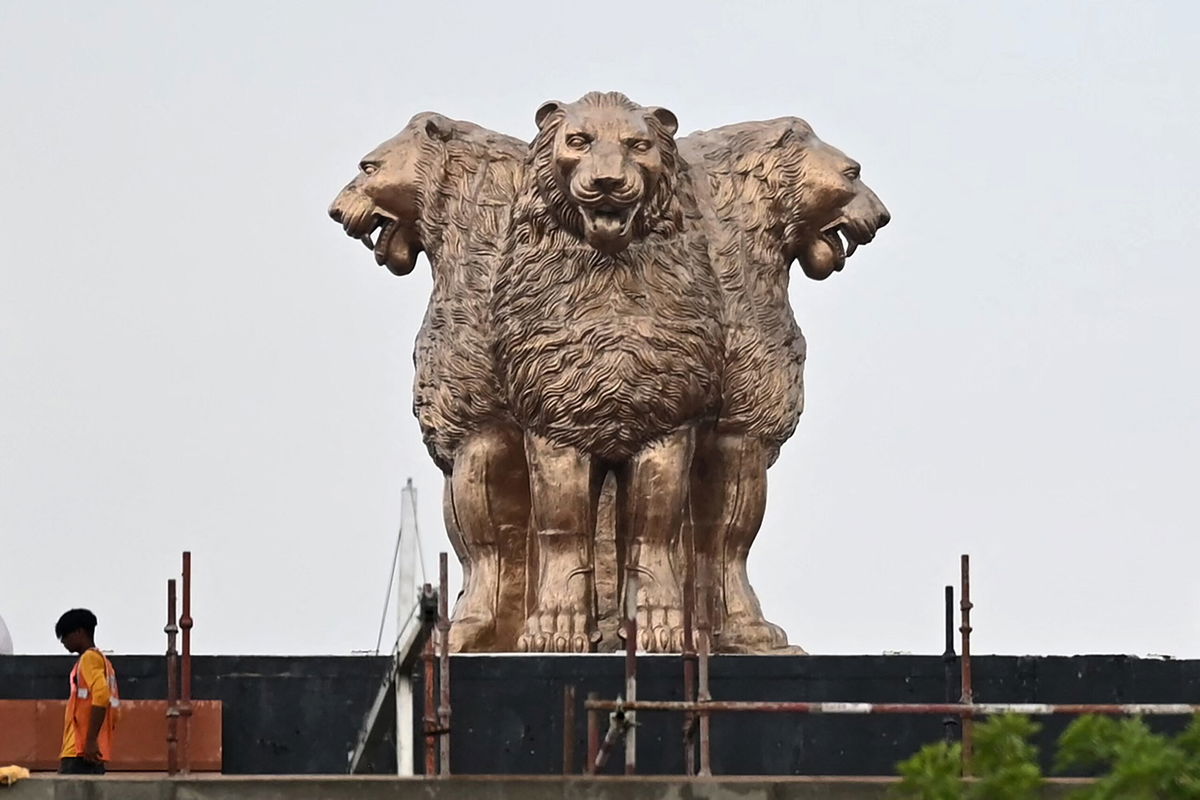New giant lion statue on Indian parliament building sparks political spat

A worker walks past the newly inaugurated 'National Emblem' installed on the roof of the new Indian parliament building in New Delhi on July 12.
Oscar Holland, CNN | Esha Mitra, CNN
A statue of India’s national emblem, unveiled this week atop the country’s new parliament, has been slammed by government critics for its “unnecessarily aggressive” appearance.
Officials maintain that the 10-ton bronze sculpture, which depicts four lions, is an enlarged like-for-like replica of the ancient statue the emblem was modeled on. But opponents were quick to suggest that the creatures had been given intentionally “snarling” expressions and sharpened teeth, describing the alleged move as a symbol of Prime Minister Narendra Modi’s politics.
The 21-foot-high statue was unveiled Monday at an inauguration ceremony in New Delhi attended by Modi, who partook in a prayer at the site. The Indian prime minister later posted a video of the event, as well as footage of him meeting laborers involved in building the soon-to-open parliament.
The statue is based on a 3rd-century BCE sandstone sculpture known as “Lion Capital of Ashoka”, which was erected on a pillar by the Emperor Ashoka at Sarnath, in present-day Uttar Pradesh.
Following India’s independence from Great Britain in 1947, a two-dimensional rendering of the statue — featuring three of the lions, with the fourth obscured from view — was adopted as the State Emblem of India. Today, it features on official government letterheads, as well as the country’s passports and currency.
Jairam Ramesh, a member of parliament with the opposition Indian National Congress party tweeted to say that the newly unveiled statue changed the “character and nature of the lions,” describing it as “a brazen insult” to a national symbol.
Jawhar Sircar, a politician in the Indian parliament’s upper house, meanwhile described the lions as “snarling, unnecessarily aggressive and disproportionate.”
Other high-profile figures also weighed in, with lawyer and activist Prashant Bhushan suggesting that the depiction of “angry lions with bared fangs” reflected the current political climate. “This is Modi’s new India!” he tweeted.
Prominent members of Modi’s ruling Bharatiya Janata Party (BJP) spoke out in defense of the statue, however. Politician Amit Malviya, who heads the BJP’s IT division, said there had been “no change” in the lions’ appearance. “The opposition is comparing 2D images in print to an imposing 3D structure,” he wrote. “They have lost it.”
Senior government minister Hardeep Singh Puri, meanwhile attributed alleged differences to the new statue’s larger size and height, arguing that the ancient original “would look as calm or angry” if viewed from below.
“Beauty is famously regarded as lying in the eyes of the beholder,” he tweeted. “So is the case with calm & anger.”
Appearing on TV news network India Today on Tuesday, the sculptor behind the work, Sunil Deore, said the lions’ teeth were simply more visible when viewed from beneath. Demonstrating with a scale model of the statue, he added: “The angle makes a lot of difference.”
“If you check its proportions and the proportions of my lion, it has been enlarged exactly,” he said, before claiming: “My brief was to create a replica of the (original) sculpture.
Deore also denied suggestions that anyone had asked him to enlarge the mouth or make the lions appear angrier.
But the criticisms leveled against Modi’s government were not solely about the lions’ appearance.
Some opponents saw Modi’s involvement in Monday’s inauguration ceremony — especially in the absence of opposition leaders — as breaching the constitution’s separation of legislative and executive powers. Others considered Modi’s prayer offering as inappropriate, given that he was opening a secular national building.
“As head of (India’s government), @PMOIndia shouldn’t have unveiled the national emblem atop new parliament building,” tweeted Asaduddin Owaisi, a member of parliament and leader of the All India Majlis-e-Ittehadul Muslimeen political party. The move “violated all constitutional norms,” he added.
The new parliament, announced less than three years ago, is expected to open in October, just months after the upcoming 75th anniversary of Indian independence. The building forms part of the Central Vista Redevelopment Project, a $1.8 billion overhaul of New Delhi’s historic administrative center that has attracted criticism from politicians, architects and heritage experts over the cost and timing of the works.
Supporters of the project have argued that the current parliament is unfit for purpose. The building’s architect, Bimal Patel, told CNN last year: “We need to improve the technology, we need space for dining, we need to create toilets, we need to create storage space, and office and administration space — it’s very clear that it can’t be done in the space available.”
Top image: A worker walks past the newly inaugurated statue on the roof of the new Indian parliament building in New Delhi on July 12, 2022.
The-CNN-Wire
™ & © 2022 Cable News Network, Inc., a WarnerMedia Company. All rights reserved.